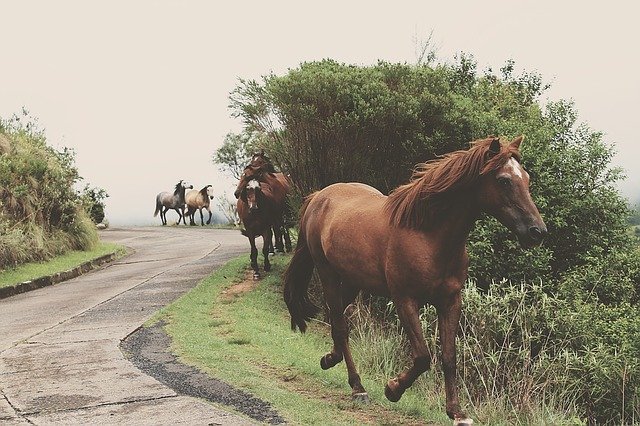What to Do When Horses Escape: Capturing a Loose Horse
When horses escape, the first tendency is to panic. However, calm determination is required for capturing a loose horse, and delays can be costly.
Horses are curious animals, and given the opportunity, they will escape. An open barn door, a rusted gate latch and low fencing for horses can all contribute to escaped horses, and this situation can result in catastrophe. Proper farm control requires a protocol for quickly capturing a loose horse. A well-defined capture protocol and robust rural animal fencing are your best allies to avoid such nightmares. With secure enclosures and a straightforward course of action, even a solo operator can handle an escape calmly and confidently.
The appropriate response when horses escape depends on the environment in which they have gotten loose and the resources available to capture them. For example, a stable in a suburban area with 50 people on hand to help is different than a remote rural barn with a sole operator.

Notifications When Horses Escape

The first step to capturing a loose horse is to notify anyone who needs to know. If there are lots of people around, someone should yell to make sure people realize that there are horses on the road or in the pasture, or in the stable yard.
If one person is alone at the barn, he should notify people who can help with the capture mission. This might include the horses’ owners, the barn manager, the barn owner or a local veterinarian. If possible, it is a good idea to call in reinforcements and to know people who are willing to help.
In some cases, it is also necessary to notify the local police. A horse on the road, for example, constitutes a public emergency. If a motorist were to hit a loose horse with his car, the accident could result in serious property damage, personal injury and even death.
Beyond relying on human eyes and traditional methods, consider tech-powered solutions: equip horses with GPS trackers for real-time location data, broadcast urgent pleas on local horse communities via social media, and invest in pre-programmed alert systems that inform key contacts when sensors detect an escape. These modern tools can drastically improve response time and coordination, bringing your equine adventurers back home faster and safer.
Removing the Escape Routes
The first step when horses escape is to close off as many areas of escape as possible. For instance, if the horse is loose in the stable yard, the goal should be to prevent him from running into the street or into a larger open pasture that is open to the outside.
Someone should close all gates or otherwise block avenues of escape. Vehicles are an excellent resource in this situation because they are large and can be moved easily. Very few horses will crash into a car or truck because it is highly visible.
Capturing a Loose Horse with Feed
The most obvious response when horses escape is to attempt to lure them back into confinement. Feed is an excellent motivator in a pinch; safety is more important than proper training methods.
Capturing a loose horse might be made easier by:
- Shaking a can full of grain
- Dropping hay on the ground near the barn
- Extending a horse treat in the hand
- Opening bags of grain
- Holding out a carrot or other favorite treat
Unfortunately, this method of capturing a loose horse will usually only work if the horse is within sight or hearing distance. When he gets too far away, his adrenaline and excitement will block out all other sensory input, and he’ll be less likely to respond.
While close-distance food enticements have their place, think longer-term. Craft a calming oasis near the barn entrance: gentle music, open stalls, and inviting bedding. Station trusted individuals in non-threatening colors near potential re-entry points, offering safe passage back. Remember, patience reigns supreme. Resist the chase, stay quiet, and watch for those homecoming signals.
The farm control protocol should define areas of escape and should assign people to cover various areas. An organized response is the best hope of capturing a loose horse.
Narrowing the Gap

If feed is not an option when horses escape, it is important to systematically narrow the gap between the horse and the outside world. This usually involves people circling the horse with as little distance between them as possible. When the horse approaches, waving hands in the air will cause him to change directions, allowing people to close in around him.
Communication is essential. Calling out to one another about escaped horses or talking via cell phone will make the job much easier. It is also a good idea, again, to be in contact with a local veterinarian who can assist if anything goes wrong.
Preventing Horses from Escape

Once horses escape, most stables set up farm control measures to help keep horses contained. It is better to do this before disaster occurs to keep all horses safe.
A self-contained farm is a safer farm. There should be appropriate fencing for horses around the entire property, with gates for controlled access. All employees and horse owners should be educated about proper farm control, from latching gates thoroughly to keeping an eye out for escaped horses.
Conclusion
Horses on the loose, even your spirited Spotted Saddle Horse, require composure. Prioritize clear communication, alert others, secure escape routes, and notify authorities if needed. Craft a calming haven near the barn, luring with familiarity. Remember: patience, not pursuit, systematic circling if required, and clear communication between crew. Invest in proactive control: robust fencing and vigilant eyes prevent escapes before they happen. Calm, coordination, and preparation bring your wanderer home safe and sound.






